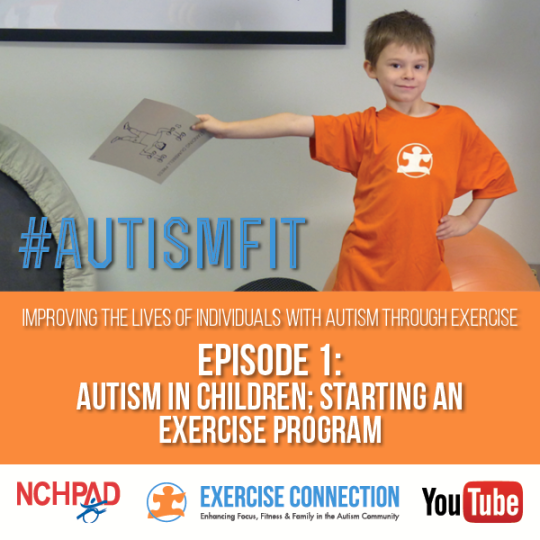Written by David S. Geslak, BS, ACSM-HFS, CSCS on behalf of NCHPAD
In physical activity settings, children with autism spectrum disorders (ASD) are often left wandering and confused. The un-sensory-friendly environment, variety of learning styles and lack of visual supports has made the typical physical activity environment a missed opportunity. However, we can turn this around by working with user-friendly tools and programs that can make physical activity for individuals with ASD more adaptable, enjoyable and productive.
The health-related benefits of physical activity paired with decreased stereotypy and self-stimulating behavior are the most common behavioral improvements following physical activity for children with ASD. These benefits further increase with vigorous exercise along with appropriate behavior management practices.
My name is David Geslak (Coach Dave), Founder of Exercise Connection, and for the past 10-years I have been successfully designing autism fitness programs and resources to address the difficult task of introducing exercise to individuals with autism. Partnering with NCHPAD, we have released a video series, “Improving the Lives of Individuals with Autism through Exercise”, that will help parents, caregivers, educators and therapists introduce exercise to their children or students on the autism spectrum.

Myself, Coach Ashley, and the Exercise Connection Champions will teach exercises and activities using best practice autism teaching strategies, visual supports, and the ExerciseBuddy App. This series can be used in a physical education class, at home, as a sensory break in school, or incorporated into the special education classroom.
As an introduction to some concepts you will see in this series, here are the Top Four Exercise Success Strategies for Individuals with Autism:
1. USE PICTURES
Many people on the autism spectrum benefit from visual supports; they can be especially helpful when you start incorporating exercise into part of your child or student’s regular routine. The pictures teach and show them what is expected and assist you as the parent or professional. Our NCHPAD video series, my book and ExerciseBuddy provides specific visual supports to help you get started.
2. ESTABLISH STRUCTURE
Structure and routine are vital for children’s development; particularly if they are on the autism spectrum. However, when it comes to exercise, think of regular as opposed to daily. You might want to start out one to two times per week and then work up to three to four times per week. Slowly integrate exercise in order to set you and your child up for success.
3. APPLY IN CROSS CURRICULUM
Exercise is a lifestyle change or addition. Incorporate exercise across many areas of the child’s life by educating those who are in their network. Exercise is not only for gym class, it can be a sensory break as well.
4. PERFECTION IS NOT THE GOAL – PERSISTENCE IS
Be patient, be kind, and be persistent. Our kids hear “no” way too often. Exercise must be a positive experience. Simply get them moving, to avoid long bouts of sedentary time, in a safe manner without a rigorous focus on form.
Episodes will be released online via YouTube, Twitter and bit.ly/autismfit. Follow @NCHPAD and @ExerciseConnect for updates.
Spread the word via Twitter with this suggested tweet:
Learn about Exercise, Autism, & New Possibilities from @NCHPAD & @ExerciseConnect in the BAYW blog! #AutismFit http://odphp.tumblr.com/